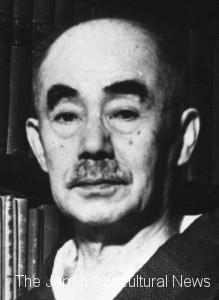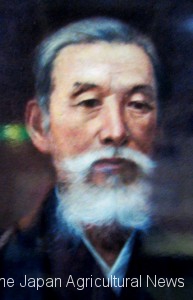Conflict on “Shinyokumiai theory”
Shinyokumiai bill was scrapped, but it was a big stimulus to Hotokusha. In 1892 (Meiji 25), In response to lobbying of Yajirō Shinagawa and Tosuke Hirata, volunteer members of Hotokusha opened the “Shinyokumiai (credit cooperatives) study group” at the hotel “Fukuzumi-ro”, managed by Masae Fukuzumi, disciples of Sontoku. Due to disease, Hirata asked 2 agents to attend the group instead of him and bring newly bestowed “Shinyokumiai (credit cooperatives) theory” and template of the Articles of Incorporation. This “Shinyokumiai (credit cooperatives) theory” was composed of opinion on improvement and with the excerpt of the official book. In the core of the opinion, as well as the former book, Hirata urged the Hotokusha’s molt to the form adapted to capitalism.
Although part of Hotokusha was converted to Shinyokumiai, but rest of Hotokusha did not choose full conversion to Shinyokumiai in accordance with the intention of the bureaucracy. Totominokuni (Tōtōmi Province) Hotokusha, the predecessor of Dainippon Hotokusha, which founded the Kakegawa Shinyokumiai (credit cooperatives) that combined economy and moral, choosed the path of the remains of the past.
Financial functions versus Hotoku thought
The government continued to focus on the Hotokusha. At that time Kunio Yanagida, scholar of Japanese native folkloristics, appeared.
In 1900 (Meiji 33), Yanagida graduated from the Tokyo Imperial university. He entered the Ministry of Agriculture and Commerce so as to follow the path of the bureaucracy while having a strong interest in sangyokumiai (cooperatives). When he was working in the bureau, he had a lecture titled “Hotokusha’s reform and Shinyokumiai” in front of the members at Totominokuni (Tōtōmi Province) Hotokusha. Ryoichiro Okada, president of the Hotokusha, was absent that day.
His lecture was documented and published in “Shimin (the people)”, Chuo (central) Hotokukai journal. Okada immediately refuted. This was also listed in the “Shimin”, and controversy was noted.
Yanagida considered, “Under money economy, Hotokusha must not remain in organization of Jukkyu (poor relief). It should have industrial finance function.” He advanced the argument considering “By linking with the spirit of sangyokumiai (cooperatives), Hotokusha can become the ideal one.” (Takashi Fujii ” Kunio Yanagida ‘s reform proposal of Hotokusha, Conversion to profit organization”, The research of Japanese economic thought history No.12).
First of all, he cited advantages of Hotokusha better than Shinyokumiai. First, he assessed the “organized activities in smooth progress.” In addition, “join condition is generous, the purpose of the union is extensive. Without asking for capital to external, educational effect is observed,” he said.
However, there was no mercy even for the problems and issues. Mainly certain points were 4, as follows;
1)Nevertheless having accumulated a lot of money, Hotokusha does not have the credit business such as deposit and loans, 2) Giving reward to diligence people is obscurantist policy, 3) Bid loan system is meaningless because it is substantially order lending, 4) While reciting non-interest-bearing loan, in fact, borrowers must pay key money named “Ganjokin,” which hits the substantially interest to be criticized as hypocrisy from the outside.
Yanagida, for 1), since the purpose of accumulating funds is in the lean, it should become Shinyokumiai (credit cooperatives) with main business of deposit and loan. He claimed business of from 2) to 4) are not suitable to reality.
Against criticism by Yanagida, Okada refuted as follows;
Regarding 1), “primary purpose of Shinyokumiai (credit cooperatives) is to make the financial valve. On the other hand, primary purpose of Hotokusha is to make morality and financial valve is secondary purpose,“ he answered. In addition, at the case of poor harvest in the Northeast, Hotokusha must immediately aid requiring a lot of capital accumulation. Regarding 2) Yanagida is confused to think the reward as the bestowal of the rescue. Hotokusha gives a reward with the intention to recognize the honor. Regarding 3), there are various differences in the way of bid loan by Hotokusha. So, Okada agreed with Yanagida in this point. There were also different ideas in the internal of Hotokusha. Regarding 4), there were differences between Hotokusha. Okada recognized that it was not substantially non-interest bearing, but “Hotokusha’s business is based on Hotoku thought and economy and morality are integrated in its business.” (Nobuhisa Namimatsu “development of Agricultural Policy Science by Kunio Yanagida, on Sangyokumiai and Hotokusha” = Kyoto Sangyo University Papers No. 27).
Kunio Yanagida
Founder of Japanese native folkloristics Familiar with agricultural policy
Kunio Yanagida, also referred to as the founder of our country folklore, was known as the author of the ” Tōno Monogatari (The legends of Tono)”. On the other hand, Yanagida was also the agricultural policy experts. He entered the Tokyo Imperial University and studied under Kuranosuke Matsuzaki, agricultural policy scholar. After graduation, he worked in the Agricultural Division of the Ministry of Agriculture and Commerce, while being belong to graduate school. He was appointed Counsellor of the Legislation Bureau, and commissioned secretary of “Zenkoku nojikai (National Chamber of Farming)” in 1903 (Meiji 36).
At his Meiji and Taisho period, he wrote lots of books related to agricultural policy. He was strongly interested in sangyokumiai(cooperatives), and wrote “Hotokusha and Shinyokumiai (credit cooperatives)”, “History of sangyokumiai,” “Moral molecule of sangyokumiai”, ” mission of sangyokumiai”, and so on.
Later, at his Showa period, he mainly wrote ethnographic books such as “Rice cake and rice porridge,” “Customs memorandum”, “Rural villages and Autumn Festival.”
【Booklet】Beginning of Cooperatives <Sangyokumiai (cooperatives) ⑤> The bill passed(2015 July 18)



